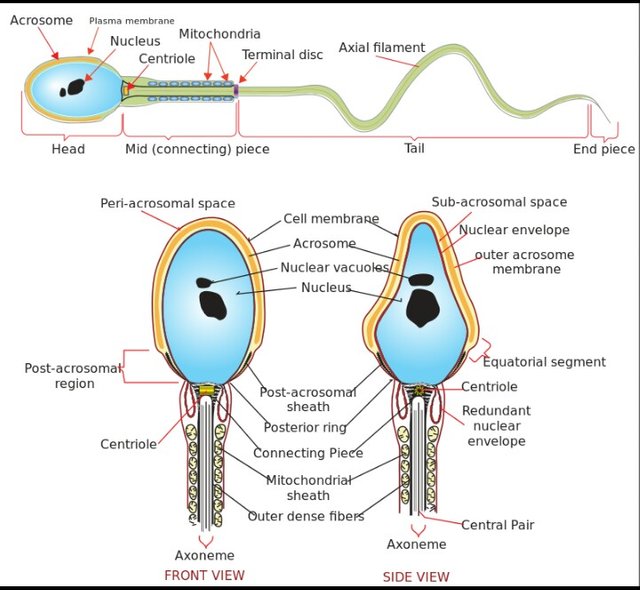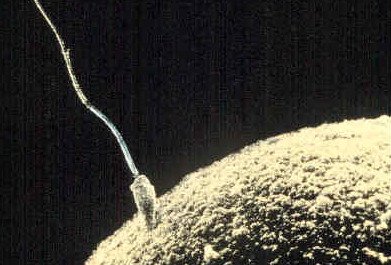Meet the Sperm - Describing fertility at the speed of light
In the thirties of man, the production rate of sperms, however, reduces with age.

Complete diagram of a human spermatozoa [Image credit - Wikimedia commons, Public Domains]
Sperm is the single crowded reproductive cell of a mature male that is produced from the testes during sexual reproduction for the fertilization of the mature ovum.
Due to the single set of unpaired chromosomes present in the human sperm cell (haploid cell), a cell having a pair of each type of chromosome (referred to as diploid cell) is formed when the 23 chromosomes of the mature egg comes in contact with the 23 chromosomes of the mature male Sperm cells.
There is no knowledge of how long this tiny guys can survive in the male's body, however, they wouldn't give up the ghost in the female reproductive system after the forcible ejection of semen into the woman's vaginal until after 5 days of survival.
These little guys were able to live for few hours only when deposited outside the body in a fresh semen sample taken immediately after ejaculation. Furthermore, semen were also collected, closely examined and frozen at a "negative 90 degrees Celsius", and the sperm in this frozen semen was observed to be able to live for a very long period of time, however, the longest period of survival has been recorded to be 21 years.
That's for a pretty very long time than I could have imagined...Smiles!
I guess you guys might look confused right now with a question bubbling through your mind. Maybe you want to ask me this; What's the difference between semen and sperm ?
Well I'm just going to keep that simple and sweet. Sperm is the reproductive cell of a mature male that can only be seen with the help of a microscope, while the common whitish viscous liquid that encloses within it millions of sperms and is easily visible to the eye is called semen.
History and developmental stages of the sperm cells

A portrait of Antonie van Leeuwenhoek (1632–1723) by Jan Verkolje [Image credit - Wikimedia commons, public domain]
The sperm has been said to develop as an undifferentiated cell (spermatogonium) in the male testicles. The spermatogonium then develop in a huge diploid cell (primary spermatocyte) and a haploid cell (secondary spermatocyte) is formed by the first meiosis division of the primary spermatocyte. The usual tail of the sperm is then formed in the stage with any of the four haploid cell present (referred to as spermatid stage), which is derived from the spermatocyte. Finally, a mature sperm cell called spermatozoon is then produced.
The early developmental stages in the production process of the sperm cells (spermatozoon) takes approximately 70 days to reach completion. After another 60 days, The sperm cells attain full maturation at a time it is called spermatozoan and are transported in a semen produced in the prostate gland, urethral glands and seminal vesicles, which flow with relative ease out of the male body.
The Structure of human sperm cells - Its size and parts

Electron micrograph of human spermatozoa magnified 3140 times [Image credit - Wikimedia commons, public domain]
- Head
- Neck
- Middle piece
- Tail
Head
The head of a sperm is made up of the acrosome which produces a specific kind of enzyme called spermlysin required for the dissemination of the female egg. At the same time, this acrosome form a close fitting cover for the nucleus with compactly looped chromatin fibers directly below it, pretty much like the cap will do on a man's head. It has been observed using a microscope that the thin head with the shape of a disc is no larger than 5.1 micrometers by 3.1 micrometers in size.
Neck
The 0.03 micrometers sized neck is made up of a proximal centriole that is enclosed within the egg during fertilization, and a distal centriole which helps in the formation of the tail. It's the most smallest part of the sperm.
Middle piece

structure of ATP tetraanion, the majority ATP species in solution [Image credit - Wikimedia commons, creative commons]
The tail, also called flagellum is the direct opposite of the neck in terms of their sizes as it is the longest part of the sperm with 50 micrometers in length. The lashing flagellum is responsible for Propelling the spermatocyte towards an egg for fertilization.
A researcher, David Zabeo observed that there is a spiral structure in the sperm tail extended inward from the extreme end of the sperm, with the aid of a 3-D imaging known as cryogenic the electron tomography. Despite the purpose of the spiral structure being unknown yet, there is an ultimate belief that it might provide solution to fertility problems in male in the nearest future.
The tortuous journey of the great sperm - How fast do sperm swim ?

A sperm cell attempts to penetrate an ovum coat to fertilize it [Image credit - Wikimedia commons, public domain]
Based on this given fact, we can deduce that it should take nothing less than a minimum of 44 minutes (i.e.175 mm divided by 4 mm) and a maximum of 3 hours (i.e.175 mm divided by 1mm, divided by 60 minutes) for the sperm to get to the fallopian tube and fertilize the eggs. But in real life, it takes upto 3 days for the sperm to reach its destination for effective fertilization.
The setback mentioned above might be due to some hurdles that can stand in the way of the sperm towards their destination. These hurdles include the following factors:
The acidic environment of the vaginal, which should normally be between 3.8 and 4.5 PH value.
The cervical mucus produced from the cervix.
Another barrier is when the utero-tubal Junction is being contricted or blocked.
Lastly, when the sperm is seen as an infectious and strange intruder by leukocytes also known as white blood cells, of the immune system.
However, we should take note of the fact that a man's body reabsorb the sperm cell that doesn't ejaculate .
My say on sperm count
Sperm count is a significant fertility factor, which is a measure of the total number of sperm in a given or measured amount of semen, as a guage for the determination of man's fertility.

[Image credit - Pixabay]
Despite some recent works suggesting the stability of sperm counts, some research recently provided back up for the report of the 1992 tests which showed a 50 percent reduction in the amount of sperm counts, from a measured figure of 113 millions per milliliter to 66 millions per milliliter of semen within a space of 52 years between 1938 and 1990.
In contrary to the claim that sperm count decline, subsequent researches made in reference to that of 1992 querried the authenticity of the report of sperm declination.
The average total number of sperm per milliliter of semen can be increased by getting enough sleep, avoid taking alcohol and drugs in excess, doing exercises, getting enough Calcium and vitamin D, eating foods that help improve sperm count and lots more.
Conclusion
In conclusion, It has already been said that about 250 millions Sperm cells are carried through a measured sample of seminal fluid by a male into the woman's vagina. However, only one of this would fertilize the egg out of the few that have the opportunity to make it into the fallopian tubes. If this happens successfully, then there is possibility of having a new born baby 9 months from that time.
REFERENCES
Sperm
Top 10 Facts You Didn’t Know About Sperm
Difference between sperm and semen
Human Sperm Has a Surprising Tail Shape We've Never Noticed Before
Human sperm
Nine things you never know about sperm
What are the best ways to increase sperm count?
How sperm are made
Spermatozoon
It's quite interesting to be a bonafide member of the steemstem community. If you write STEM (Science, Technology, Engineering and Mathematics) related topics, kindly join on on our discord channel here
Sperm
Top 10 Facts You Didn’t Know About Sperm
Difference between sperm and semen
Human Sperm Has a Surprising Tail Shape We've Never Noticed Before
Human sperm
Nine things you never know about sperm
What are the best ways to increase sperm count?
How sperm are made
Spermatozoon
It's quite interesting to be a bonafide member of the steemstem community. If you write STEM (Science, Technology, Engineering and Mathematics) related topics, kindly join on on our discord channel here
Sperm and egg (germinative cells) are referred to as haploid cells, because they carry 23 chromosomes, which is half of the genetic material contained within somatic cells (46 chromosomes), which are referred to as diploid.
Thank you very much, that was sure a typo error and I have made correction to that.
Thanks for stopping by
✅ @olasamuel, enjoy the vote!
Have you claimed your FREE Byteballs yet? Check out this post on how you can get $10-80 just for having a Steem account: https://steemit.com/steem/@berniesanders/get-free-byteballs-today-just-for-having-a-steem-account-usd10-80-in-free-coins
Congratulations @olasamuel! You have completed the following achievement on Steemit and have been rewarded with new badge(s) :
Click on the badge to view your Board of Honor.
If you no longer want to receive notifications, reply to this comment with the word
STOP